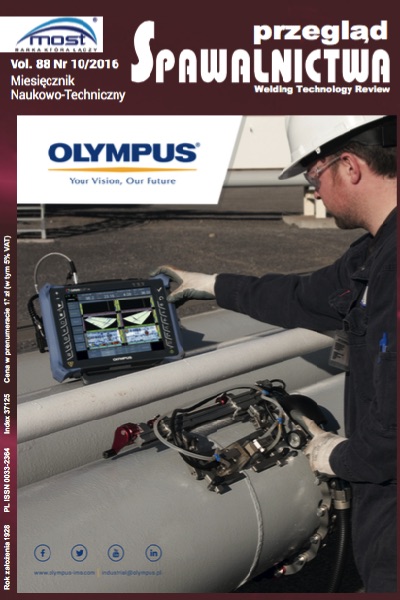Dlaczego zaleca się stosowanie profesjonalnych ośrodków sprzęgających w badaniach ultradźwiękowych?
Main Article Content
Abstract
Ośrodki sprzęgające pełnią w badaniach ultradźwiękowych niezwykle ważną rolę, umożliwiając przejście fali ultradźwiękowej z jednego ośrodka do drugiego. Dla prawidłowego przeprowadzenia procesu badania istotny jest dobór odpowiedniego sprzęgacza. W poniższym referacie przedstawiono wpływ impedancji akustycznych ośrodków sprzęgających na wysokość amplitudy echa, a także ich zależności od współczynnika tłumienia. Na podstawie analizy dostępnych materiałów stwierdzono zmniejszanie się wysokości echa dna oraz współczynnika tłumienia wraz ze spadkiem impedancji akustycznej sprzęgaczy dla tego samego poziomu wzmocnienia. W pracy przedstawiono również wpływ sprzęgacza na powstawanie zjawiska korozji w badanym materiale.
Why is it recommended to use professional coupling agents during ultrasonic examination?
Abstract
Coupling agents are very important in ultrasonic testing they let the wave to transmit across the interface, from a transducer to a test material. Choosing the right couplant is of great significance for the whole examination process. In this paper, various couplants and their influence on the amplitude of back wall echoes and attenuation coef- ficients are presented. It was observed, that the amplitude of back wall echo and attenuation coefficient were decreasing with the acoustic impedance of used couplants - these relations were linear. This paper contains also information about how big is the influence of couplant type on corrosion process forming and spreading on examined material.
Downloads
Article Details
Creative Commons CC BY 4.0 https://creativecommons.org/licenses/by/4.0/
Welding Technology Review (WTR) articles are published open access under a CC BY licence (Creative Commons Attribution 4.0 International licence). The CC BY licence is the most open licence available and considered the industry 'gold standard' for open access; it is also preferred by many funders. This licence allows readers to copy and redistribute the material in any medium or format, and to alter, transform, or build upon the material, including for commercial use, providing the original author is credited.
References
M.K. Lipnicki, Badania Ultradźwiękowe, cz.1: Podstawy Teoretyczne; wyd. 5; Gdańsk, 1998, Koli Sp. z o.o.
M. Larsson, Ten Criteria for Accurate Ultrasonic Couplant Selection; Inspection Trends, Spring 2009, str. 24
N. Netshidavhini, R.B. Mabuza Effects of Various Couplants on Carbon Steel and Aluminium Materials Using Ultrasonic Testing; 18-sta Światowa Konferencja Badań Nieniszczących, 16-20 kwietnia 2012, Durban, RPA
Y.H. Kim i inni A Study of the Couplant Effects on Contact Ultrasonic Testing; Journal of the Korean Society for Nondestructive Testing, vol. 22, nr 6, 2002
Couplant vs Wallpaper Paste, Apllication Case Study; Sonatest Ltd.; 2015
